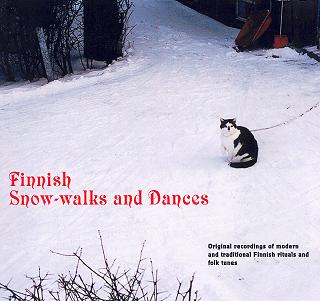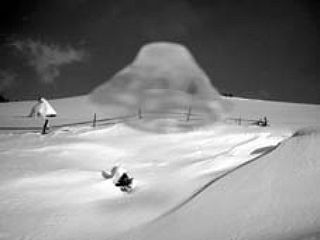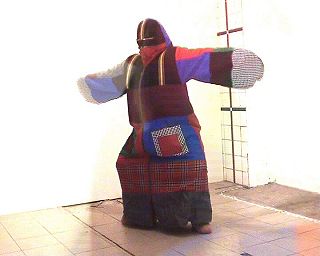
Finnish Snow Walks and Dances | Various Artists | Raw Audio
Gruen 032 | Raw Audio | LP > [Sold Out]
LP still available from:


Introduction
Recordings of Snow Music are rare, and even more rarely are they presented to a greater public. This may seem curious, considering that the Kalevala, the national epos of the Finnish people, explicitly mentions songs scooped out of the frost. Despite this lack of official presentation, snow tunes and rituals have been performed long before and after the publication of the Kalevala in 1835.This album now lays some of the finest examples of Finnish Snow Music in your hands. Most of the material ori-ginates from field recordings made in North Karelia and Lapland. The modern pieces were recorded in Helsinki, Turku and Tampere.
Snow Music can be performed in a variety of manners: traditional, modernist, eccentric. And a new generation of musicians has taken on the task of evaluating and redefining the older traditions of ritual tunes and word magic. The impact of Snow Music has grown with the increasing need for a musical identity incorporating the poetic universe of snow. With this compilation, Snow Music marks its entry into the 21st century.
Sisukas Poronainen, February 2005
Side A
01
Porotanssii, Traditionaal
Reindeer Dance, Traditional
In September the reindeer slaughtering season starts and lasts usually until October. Lapland men from the vicinity of Kittilä preparing for slaughter perform a short ritual dance, using pieces of reindeer antlers as a percussive element. The guitar-like string sound stems from a tree harp: a metal chord is tightened between two branches, and picked in an off-beat manner. Recorded: 7.1.2002, KittiläTree harp played by Kalli Kaksi
02
Lumiympyräkävely
Circular Snow Walk
Walking in the snow is a vital element in the lives of all northern peoples. This recording was made during a snow walk circling around a fir tree at a distance of approx. 10 feet. This is intended to calm the mind. Circular snow walking often involves the use of an accompanying instrument, in this case a balalaika.
Recorded: 16.1.2002, Kuhmo, North Karelia
03
Saippuakauppias
Seller of Soap
Traditional song of the soap sellers, who, in the springtime, used to travel from village to village selling soap made of birch leaves. Only the rhythm has been preserved, the wording of the song has been lost. Note that the Finnish word for soap seller is a palindrome. Accordingly, the beat structure is arranged in such a manner that the song can also be played (sung) backwards. Recorded: 15.3.2002, Vaala, region of Oulu Performer: Päiva Rumalainen
04
Kantele Rekiretki
Kantele Sleigh Ride
A kantele is a traditional Finnish plucked string instrument. The oldest forms of kantele have five to fifteen strings and a carved wooden body. It has been critically acknowledged that the origin of the Kantele goes back to the tree harp. The sleigh ride is a common theme in folk music among all northern nations. This short improvisation introduces several variations, using percussive elements to accentuate the increasing speed of the sleigh, ending with a somewhat dreamy sequence. Recorded: 7. 1. 2002, Lieksa, North Karelia Kantele: Onnellinen Hampurilainen
05
Hiprakkainen Lumihiutale Valssi
Tipsy Snowflake Waltz
The tradition of family music has been kept alive through the generations until nowadays. Especially in wintertime, people gather after a good meal and start up a true competition in playing folk songs. The use of self-manufactured instruments is abundant: Here, an improvised washboard made out of fish bone plays the intro. Lumihiutale Valssi is a typical example of a popular folk tune. The final note ends on the dominant chord, clearly breaking with our usual listening habits, but this is also a true demonstration of the intriguing way in which the Finns alter traditional pop music patterns. Recorded: 21 .2 .2002, Espoo Guitar: Endru Krellainen Kantele: Onnellinen Hampurilainen
06
Vuoren Villit
The Hoards of the Mountains
Alcohol-induced hallucinations are common on the occasion of the extensive feasts held in the region of Puulavesi. The feasts take place either at home or in the wilderness. Regardless of the place of the event, at the peak of drinking some men become susceptible to visions which involve the apparition of a mysterious Hoard of the Mountains, as recorded on this track, on New Year’s Eve 2001. As the situation was a German-Finnish meeting, this extraordinary visionary moment is worded in English. Recorded: 31. 12. 2002, Puulavesi
07
Unelma Valssi Remixi
Dreamy Waltz Remix
This Dreamy Waltz is a good example of how traditional material is combined with modern vocal and instrumental improvisation. Bits and pieces of melodies and samples are loosely grouped around the motive of the Porotanssi and a slow waltz theme from the 19th century. Snow walk recordings form part of the arrangement. Recorded: 22 .12. 2002, Tampere Artist: Neito Kiharatukka
Side B
01
Tytönhamepilvet
Maiden’s Skirt Clouds
In the region around Inari, snow clouds materialize in midair, apparently independent of any prevailing meteorological conditions and hover unusually close to the ground. Because of their extraordinary shape, these clouds are called Tytönhamepilvet (Girl’s Skirt Clouds) by the Inari people, and when they appear, it is a sport among the boys to run and stick their heads into the clouds. The track on this album presents a sample of the sounds heard inside one of the Tytönhamepilvi. The rippling tones result from the per-manent exchange of air interstices between the whirling ice crystals. The musical pattern reminds of modern compositions based upon vocal clusters. Recorded: 12 .2. 2002, Inari Processed by: Aural Chamber Music Orchestra,Rovaniemi, 2005
02
Lumilaulu (Kansanlaulu)
Snow Song (Folk Song)
This beautiful song demonstrates the tradition of the Kaanoni, a wide-spread form of multi-layered singing practiced throughout the world. The Lumi-laulu deals with snow, of course. It is ritually performed by women only on the morning after the first snow of the year has fallen. Formerly sung in the indigenous language of the Sami (Lapland) people, the lyrics were later translated and adopted into Finnish language. The wording is simple, leaving room for improvisation ver the intricate melody: Snow has come / Lumi on tullut The world is white / Maailma on valkoinen The world lies dreaming / Maailma makaa unelmoiden Under the snow. / Lumen alla. Recorded: 3 .12. 2002, Ranua, Lappland Performers: Aili & Annikki Saari
03
Dark Cough
Dark Cough
Japanese influences have led to a widespread enthusiasm for metal and noise music in Finland, resulting in specifically Finnish forms of white noise music, known as Lumi Core (Snow Core) and it’s twin-music Lumi Noise (Snow Noise) L-Core tracks must contain more than fifty percent of original snow recordings. This quota is often surmounted, as the musicians dedicate long hours of work to sampling, collecting and editing of white noises. Additional samples should be as authentic and raw as the conditions allow for. L-Core and -Noise artists share a vivid interest in ethno-type field recordings and bio-acoustics which link their music back to the older traditions of snow music. At the same time, a new type of performance art has evolved, which clearly refers to the shamanistic rituals of the old Finnish tribes. Artist: Leikata Ja Liimata, Helsinki
04
Joen Ylitys
The River Crossing
This soundscape composition adopts a folk-tale as a musical theme. The Kettu Jäällä (Fox on the Ice)-tale is still told to keep children off the ice of newly frozen water: A young fox sets out despite his brothers warning to cross the river, which separates his village from Satumaa (Wonderland, mythical paradise of the Finns). The people of the village try to call him back, but their voices fade in the dense fog ascending from the riverbanks. The ice of the river begins to grind and crackle under his feet. Still moving on, the young fox suddenly feels himself lifted up in the air and is carried off by the north wind. Artist: Porokierros, Helsinki
05
Talvitango
Winter Tango
Travelling musicians are a common sight in Finland. The presence of the Musikantti-Kulkuri is required at nearly every feast or communal event. The hardships of travel and the strain of maintaining a high quality in performance bring forth quite extraordinary personalities. The artist of this recording states to play only four pieces a year, one for each season, in every possible interpretation. Winter tango is his 2002/9.2.-improvisation. Artist: Soolo Ennikki, Helsinki Recorded: 9. 2. 2002
12 Tracks (32’44")
LP (500 copies)
Acknowledgements:
Artists/Musicians (in alphabetical order, tracknumber): Ben Galo (12), Frau Kraushaar (7), &REW Krell (5), Martin Moritz (10), Lasse-Marc Riek (11), Jens Röhm (1,2), Gabi Schaffner (3,4,6,9), Tobias Schmitt (2), FX Schroeder (4,5) Voices on Vuoren Villit: FX Schroeder, Hannu Elenius, Voices and breathing on Dark Cough and Joen Ylity: FX Schroeder, young rapper at the Kaapeli, Helsinki (Thank you!)
All original recordings of snow walks were made in Finland, 2002; 620 OW, 24,90NS. Other circumstances: 540 0W 10,10 NS in 2005.
Idea, concept & realisation: Gabi Schaffner
Texts, photography & cover design: Gabi Schaffner
(Except dog sleigh photo: by Lasse-Marc Riek; L-Core-performer: by Cecile Noldus)
Translation support: Anna Vuorenmaa, Timo Valtonen (Finnish); Ingar Alan Milnes (English).
Additional support: Cecile Noldus, Laila Unger
Digital mastering: Lasse-Marc Riek and Tobias Schmitt
This album was made possible through the generous support of the Alte Feuerwache/Mannheim.
Copyright for the individual tracks is reserved by the artists.
Whole project: © Gabi Schaffner 2005
Number of copies: 500.
4’10’’-video/dvd is available on demand: Lumi-Core – Snow-Core by Noldus|Schaffner
Gruenrekorder / Germany / 2005 / Gruen 032 / LC 09488
Review:
01 | tokafi | Tobias Fischer
CD Feature/ "Finnish Snow-Walks and Dances" Captures the "poetic universe of snow". I bet you didn’t know that there is a Finish tradition called "Snow Walking", intended to calm the mind. It harks all the way back to the national epos, the Kalevala, which speaks explicitely of "scooping rhe songs out of the frost" and of "unlocking the box of tales". But don’t worry – not many other people have heard of it, either. The very informative text, which accompanies this release, which can either be bought as a regular CD or a luxuriously packaged, truly beautiful LP (have I made amply clear, which one I prefer?), therefore serves to outline the aims of the project: To present the entire spectrum of snow music, from its folk roots to its present forms, to capture the "poetic universe of snow" and to "mark its entry into the 21st Century". Based on the field recordings made by the famous Sisukas Poronainen from the renowned "Kansanmusiikin Instituutti"(which, I am sure, I need not explain any further), Gabi Schaffner (who has already held publich lectures on the subject) has taken on the task of sifting through the material, selecting the most representative cuts and of researching the scene for assorted genres, such as "Lumi Core" (Snow Core) and acts from the experimental scene, who are carrying on the traditions. She has found some wonderful music and a fair amount of equally fascinating stories. Take the tale of the "Tytönhamepilvet" for example, tiny clouds, which come into existence closely to the ground, which is why they are referred to as "Maiden’s Skirt Clouds". Local boys will anxiously await the day of their arrival and then run around the field, trying to stick their heads into them. The eponymosuly titled piece on the record captures the ambiance in one of these clouds, a tinkling and chiming mid-winter dream. While this track was later edited in the studio, other titles were left in their original state, such as the "Circular Snow Walk, a hypnotic melange of repetetive balalaika-patterns and the foot steps of the walkers circling a tree. The "Sleigh Ride" features a plucked motive on the ancient Finnish Kantelele, an instrument with five to fifteen strings and a carved wooden body. While the first side of the album concentrates on similar, unprocessed material, the second site investigates the current exponents of the scene, including the bizarre noise experiments of the Snow-Core bands (who ardously collect samples from snow excursions, in order to fulfill the 50% snow-quota in their music) and the dark, eleven-minute long dronescape "Joen Ylitys", which builds from a richly harmonic opening, seemingly filled with the sound of an orchestra tuning, into a dark and threatening barrier of deep bass pads.
All of this may seem like a foreign and unexplored world to you. And it seems, as though some are doing all they can to leave things this way. When we tried to find information about the contributinmg Finnish artists, we couldn’t find any and when we called the Kansanmusiikin Instituutti, they claimed to never have heard of Sisukas Poronainen. We assume this is an intended effort to stop thinking too much about the historical background and to just enjoy the music. It should be noted, however, that Gabi Schaffner’s public speech was entitled "Snow Music – Fake or truth?". And that the "Acknowledgments"-section mentions a lot of acts which have no relation whatever to Finland, but a very close one with the German Gruenrekorder label. In any case, they have remained almost entirely true to the Kalevas creed: The songs may not have been scooped exclusively from the frost, but the box of tales has certainly been unlocked.